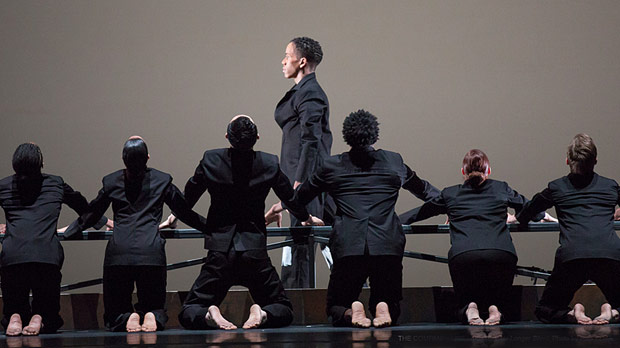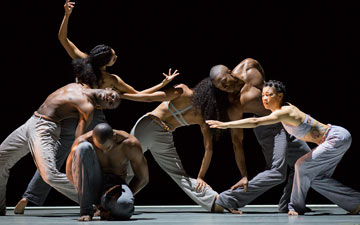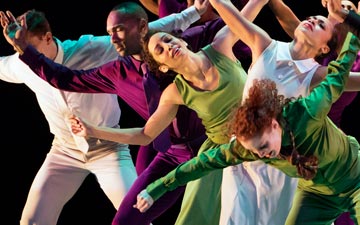
© Paul Kolnik. (Click image for larger version)
Alvin Ailey American Dance Theater
Exodus, Strange Humors, No Longer Silent, Revelations
New York, David H. Koch Theater
22 June 2015
www.alvinailey.org
Rites
Alvin Ailey American Dance Theater ended its spring season at Lincoln center with a program, on June 21, that included two season premières, a new work by Rennie Harris (Exodus), and the compay première of Robert Battle’s No Longer Silent, from 2007. The performance also included the final appearance of two company stalwarts, Antonio Douthit-Boyd and Kirven Douthit-Boyd, who recently accepted a joint post as co-artistic directors of dance at St. Louis’s Center of Creative Arts. They are not the only ones leaving – alas, the lithe, lovely Alicia Graf Mack, perhaps the company’s most elegant and elusive dancer, has also hung up her shoes to take up teaching at Webster University and Washington University in St. Louis.
I didn’t get the chance to see Ms. Mack one final time, but the Douthit-Boyd pair went out with a bang in a short duet by company-director Robert Battle, Strange Humors. It’s a slight piece, remarkable mainly for its ingratiating mixing of North-African rhythms and playful, sexy jostling for two men. Battle subdivides the men’s bodies, creating interesting polyrhythms with their heads, arms, torsos and feet. The men partner and mirror each other, perform phrases in canon, grin, leap and fall. It’s essentially a gala piece, and as such, it works just fine.

© Paul Kolnik. (Click image for larger version)
The other Battle work, No Longer Silent, is a much more ambitious project, a large-scale dance (originally made for Juilliard) set to forgotten ballet music by the Czech modernist Erwin Schulhoff. Schulhoff’s ballet, Ogelala, was written in the early twenties, and reflects the primitivist tendencies so popular at the time. There are strong echoes of The Rite of Spring, Petrouchka, and even Les Noces in the woodwinds-and-brass-heavy orchestration, slashing strings, machine-like rhythms and constantly-shifting time signatures. As in Rite, the music is subdivided into well-defined sections, each introducing a new theme. One can almost imagine the scenario driving the score. Marches give way to lyrical, pleading melodies or desperate cries on flute, clarinet, oboe.
Battle responds with a brilliant visualization of the music’s intricate parts, a kind of neo-Rite of Spring for our time. The dancers, wearing unisex black suits and subdivided into groups, march and run and roll in counterpoint. The overarching feeling is fear: heads are down, bodies crouched, arms are held up in an attitude of surrender. At one point, a woman – a sacrificial maiden – is surrounded by men; when they disperse, her trousers are down and her torso is bent back in a grotesque backbend. A symbolic rape has occurred.
The dance is full of evocative touches: a band of light that illuminate only the dances tilted faces, making them look like a row of Petrouchka dolls. Bodies raised overhead by the group, then dropped to the ground. Lines of seated dancers stomping in precise, accented rhythms while moving their upper bodies in a wave. Battle has a knack for creating striking shapes, in the vein of Ohad Naharin though not quite as extreme. A solo for Jacquelin Harris, slow and stretched, creates island of lyricism in the general mayhem. Battle’s ear for and manipulation of rhythm, too, are masterful. But for all its brilliance, No Longer Silent feels inessential, like a superbly-executed exercise. Despite its overtly militaristic style, it fails to tap into any real, gut-wrenching fears or emotions. We already have a Rite of Spring, and Ogelala doesn’t make a compelling argument for another.
The opposite is true of Rennie Harris’s Exodus, which opened the program – and of Revelations, which closed it. I’ve reviewed Exodus already, but I’ll add this: Watching it again after the bloodbath in Charleston underlined just how moving it is to see a choreographer of skill expressing the feelings and ideas everyone in the theatre is thinking about. This is the opposite of escapist art. The images of mourning, the sharp retort of gunshots, the consoling and yet tormented presence of a prophet-like figure protecting his flock – the extraordinary Jamar Roberts – feel real, honest, and of our time. On this night, the Ailey dancers were dancing for the victims, and for all of us.

















You must be logged in to post a comment.